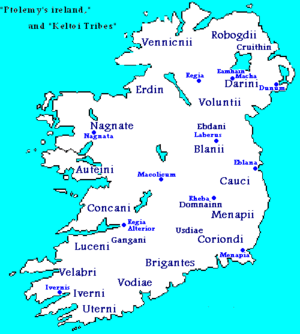Cruthin facts for kids
The Cruthin were an ancient group of people who lived in Ireland a long time ago, during the early Middle Ages. Their main home was in a part of Ireland called Ulster. This area included parts of what are now County Antrim, County Down, and County Londonderry. Some Cruthin also lived in other parts of Ireland, like Leinster and Connacht.
The name "Cruthin" is similar to the old name for the Celtic Britons. Sometimes, the word "Cruthin" was also used to talk about the Picts, who lived in Scotland. However, experts still discuss whether the Cruthin were truly related to the Britons or the Picts.
The Cruthin were made up of several smaller groups or territories. Two important ones were the Dál nAraidi from County Antrim and the Uí Echach Cobo from County Down. Early writings show that the Cruthin were different from another group called the Ulaid. The Ulaid gave their name to the larger kingdom of Ulster. Later, some Dál nAraidi claimed they were the "true Ulaid." Other groups, like the Loígis (who gave their name to County Laois) and the Sogain, are also thought to have been Cruthin.
By the year 773 AD, old records stopped using the name "Cruthin." Instead, they started using "Dál nAraidi." This happened because the Dál nAraidi had become the most powerful group among the Cruthin.
What Does the Name "Cruthin" Mean?
The name "Cruthin" has been spelled in many ways in old Irish writings. Some spellings include Cruthin, Cruithin, and Cruithni. In modern Irish, it is spelled Cruithne. The single form of the name is Cruithen.
The name might come from the Irish word cruth, which means "form" or "shape." Many experts believe the name comes from an older word, *Qritani. This word is similar to *Pritani, which was used to describe the Celtic Britons. An ancient Greek geographer named Pytheas called the Celtic Britons the Pretanoí. This later became Britanni in Latin.
It is thought that "Cruthin" was not the name these people called themselves. Instead, it was probably a name their neighbors used for them.
You can still find the name "Cruthin" in some place names today. For example, Duncrun in County Londonderry means "fort of the Cruthin." Drumcroon, also in County Londonderry, means "ridge of the Cruthin." In County Down, Ballycrune means "pass of the Cruthin," and Crown Mound means "ford of the Cruthin." These place names are believed to show where the Cruthin lands once ended.
Were the Cruthin Related to Other Groups?
Old Irish writers sometimes used the name "Cruthin" for both the group in northeast Ireland and for the Picts of Scotland. Also, in Scottish Gaelic, a Pict is called Cruithen or Cruithneach. The land of the Picts is called Cruithentúath. Because of this, some people have suggested that the Cruthin and Picts were the same people or were connected.
However, other experts disagree. Historian Francis John Byrne points out that even though Irish writers used the same name for both groups, Latin writers used different names. They used Picti only for the Picts. Professor Dáibhí Ó Cróinín says that the idea of the Cruthin being "Irish Picts" is "quite mistaken." Professor Kenneth H. Jackson also wrote that the Cruthin "were not Picts" and had "no connection with the Picts."
There is no archaeological proof that the Cruthin were linked to the Picts. In fact, archaeologists cannot tell the Cruthin apart from their neighbors in Ireland based on old objects. Records show that the Cruthin had Irish names, spoke Irish, and followed the Irish system of family inheritance. This was different from the system sometimes used by the Picts, where property passed through the mother's side of the family.
Historian Alex Woolf has suggested that the Dál Riata were part of the Cruthin. The Dál Riata were a Gaelic kingdom that included parts of western Scotland and northeast Ireland. The Irish part of this kingdom was surrounded by Cruthin lands.
Modern Ideas About the Cruthin
In the 1970s, a politician named Ian Adamson suggested a new idea about the Cruthin. He thought they were a British people who spoke a language different from Celtic languages. He believed they were the first people to live in Ulster. Adamson argued that the Cruthin fought against the Irish Gaels for many years. He saw an old Irish story, the Táin Bó Cúailnge, as a symbol of this conflict. He also claimed that most Cruthin were forced to leave for Scotland after a battle in 637 AD. Then, about 1,000 years later, their descendants returned to Ireland during the Plantation of Ulster.
Adamson's idea suggests that the Gaelic Irish were not truly native to Ulster. It also implies that the Ulster Scots were simply returning to their ancient lands. Some groups have used this idea to support their views on identity in Ireland.
However, most historians, archaeologists, and experts on ancient cultures have strongly disagreed with Adamson's theory. Professor Stephen Howe says that the theory was created to give an old reason for a separate identity in Ulster. Archaeologists like J. P. Mallory and T. E. McNeil say that the Cruthin are "archaeologically invisible." This means there is no proof that they were a separate group. They also say there isn't a single object or place that an archaeologist can clearly identify as "Cruthin."
Much of Adamson's ideas were based on an older historical model from 1946. However, this older model has since been shown to be incorrect by other experts. Also, a big study in 2017 called the "Irish DNA Atlas" looked at the history of people in the British Isles. This study showed that there is no archaeological proof for the older theory that Adamson used.
Interestingly, an asteroid in space, 3753 Cruithne, was named after the Cruthin people. Also, a fictional hero named Bran Mak Morn in old adventure stories was described as a "chief of the Cruithni Picts."


